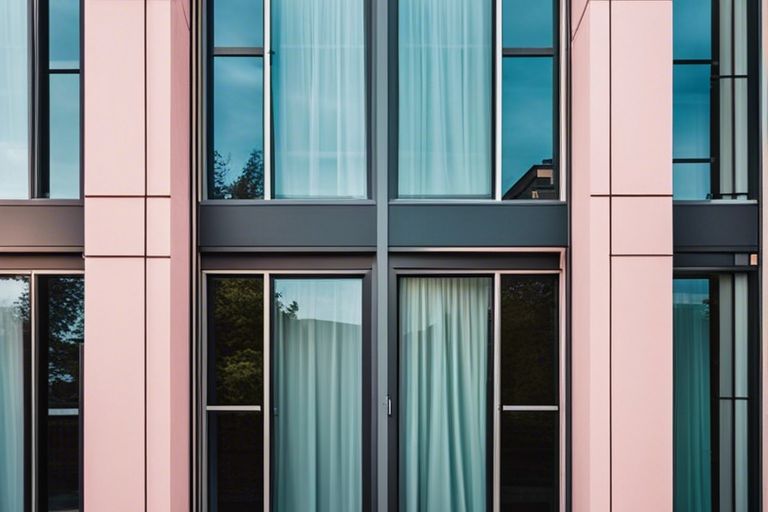You may not have heard of thermally broken aluminum windows before, but they are a game-changer when it comes to energy efficiency in your home. These windows are designed to prevent heat transfer between the inside and outside of your home, which can have a significant impact on your energy bills throughout the year. The thermal barrier in these windows helps to keep your home cooler in the summer and warmer in the winter, allowing you to rely less on your heating and cooling systems. This not only saves you money but also reduces your carbon footprint by decreasing your energy usage. If you’re looking to make your home more environmentally friendly and save money at the same time, thermally broken aluminum windows are definitely worth considering.
Key Takeaways:
- Improved Insulation: Thermally broken aluminum windows have a barrier that reduces the transfer of heat and cold, providing better insulation for energy efficiency.
- Energy Cost Savings: By reducing heat and cold transfer, thermally broken aluminum windows can lead to significant savings on heating and cooling costs.
- Environmental Benefits: Using less energy for heating and cooling not only saves money, but also reduces the carbon footprint of a building.
- Condensation Reduction: The thermal break in these windows helps to reduce condensation, which can lead to mold and mildew growth, improving indoor air quality.
- Durability: Thermally broken aluminum windows are durable and low-maintenance, providing long-term energy efficiency benefits for years to come.
- Customizable Design: These windows come in a variety of styles and colors, allowing for energy-efficient design options that match any architectural aesthetic.
- No Thermal Bridging: The thermal break in these windows eliminates the transfer of heat and cold through the frame, ensuring optimal energy efficiency throughout the entire window structure.
Types of Thermally Broken Aluminum Windows
If you are considering thermally broken aluminum windows for your energy efficiency needs, it is important to understand the different types available. Here are the types of thermally broken aluminum windows that you can choose from:
| Fixed Windows | Operable Windows |
| These windows are stationary and cannot be opened. They are a great option for areas where you want to maximize natural light without the need for ventilation. | Operable windows, such as casement or awning windows, can be opened to allow for ventilation. They are ideal for areas where airflow is desired. |
Any of these options can be designed with thermal break technology to ensure energy efficiency in your home or building.
Fixed vs. Operable Models
When choosing thermally broken aluminum windows, you will need to decide whether you want fixed or operable models. Fixed windows are best suited for areas where natural light is the primary goal, while operable windows are ideal for spaces where ventilation is a priority. Both options can provide energy efficiency benefits, so it ultimately comes down to your specific needs and preferences.
Double vs. Triple Glazed Units
Another important decision when selecting thermally broken aluminum windows is whether to opt for double or triple glazed units. Double glazed windows have two layers of glass with a layer of air or gas in between, while triple glazed windows have an additional layer of glass. Triple glazed units offer enhanced insulation and can provide even greater energy efficiency benefits. However, they may come at a higher cost. You should consider the climate and noise levels in your area when making this decision to ensure that you choose the most suitable option for your energy efficiency needs.
Factors Affecting the Efficiency of Thermally Broken Aluminum Windows
Assuming you are considering thermally broken aluminum windows for your energy-efficient home, there are several factors that can affect their efficiency. These factors include:
- Quality of the thermal break: The effectiveness of the thermal break in reducing heat transfer between the interior and exterior of the window greatly impacts its efficiency.
- Type of glass: The type of glass used in the window, such as double or triple glazing, and low-E coatings, can significantly impact its energy efficiency.
- Proper installation: Ensuring the windows are installed correctly with proper insulation and weatherstripping is crucial for maximizing energy efficiency.
- Design and engineering: The overall design and engineering of the aluminum windows can also affect their thermal performance.
Knowing these factors can help you make informed decisions when choosing thermally broken aluminum windows for your home.
Thermal Break Technology Explained
Thermal break technology involves the use of a barrier material to separate the interior and exterior halves of the aluminum window frame. This prevents the transfer of heat and cold, improving the overall energy efficiency of the window. By interrupting the thermal bridge that naturally occurs in traditional aluminum windows, thermal break technology helps to keep your home better insulated, reducing the need for excessive heating or cooling.
Importance of Proper Installation
Proper installation of thermally broken aluminum windows is crucial for ensuring their energy efficiency. A poorly installed window can lead to gaps and drafts, ultimately undermining the performance of the thermal break and insulation. Choosing a skilled and experienced installer who understands the importance of air sealing and insulation can make a significant difference in the long-term performance of your energy-efficient windows.
Step-by-Step Guide to Choosing Thermally Broken Aluminum Windows
Unlike traditional non-thermal aluminum windows, Thermally broken aluminum windows offer superior energy efficiency and performance. When choosing thermally broken aluminum windows, there are several important factors to consider. Here is a step-by-step guide to help you make the right decision:
Assessing Your Energy Efficiency Needs
Before you start looking for thermally broken aluminum windows, it’s essential to assess your energy efficiency needs. Consider factors such as insulation, climate, and the orientation of your building. This will help you determine the level of energy efficiency you require and the type of windows that best suit your needs.
Tips for Selecting the Right Window Specifications
When selecting thermally broken aluminum windows, pay attention to the following specifications:
| Insulation: | Choose windows with high-quality thermal insulation to prevent heat loss and gain. |
| Glazing: | Opt for double or triple glazing to improve energy efficiency and reduce noise transmission. |
Knowing the right specifications for your thermally broken aluminum windows will ensure optimal energy performance and long-term savings on your energy bills.
Pros and Cons of Thermally Broken Aluminum Windows
Not all windows are created equal, and it’s important to weigh the benefits and drawbacks before investing in thermally broken aluminum windows. Here are the key pros and cons to consider:
| Pros | Cons |
| Excellent thermal performance | Potentially higher upfront cost |
| Durable and low maintenance | Conductivity of metal can impact energy efficiency |
| Modern and sleek aesthetic | Potential for condensation in extreme climates |
| Recyclable and environmentally friendly | May not offer as much customization compared to other materials |
| Resistant to warping or bending | May transmit noise more than other materials |
Advantages of Investing in Energy-Efficient Windows
When you invest in energy-efficient windows, you are making a smart decision for your home. By choosing thermally broken aluminum windows, you can significantly reduce heat loss and gain, leading to lower energy bills and a more comfortable living environment. The insulating properties of these windows help to regulate interior temperatures, reducing the need for constant heating and cooling. Additionally, the long-term energy savings and potential for increased property value make it a worthwhile investment for your home.
Considerations and Potential Drawbacks
While thermally broken aluminum windows offer numerous benefits, it’s important to consider potential drawbacks before making a decision. In some cases, the upfront cost of these windows may be higher compared to other options, but it’s important to weigh this against the long-term energy savings. Additionally, the conductivity of metal can impact energy efficiency, potentially leading to higher energy usage in extreme climates. It’s also important to note that aluminum windows may not offer as much customization compared to other materials, so you’ll need to assess your specific needs and preferences before making a decision. Finally, while thermally broken aluminum windows are resistant to warping or bending, they may transmit noise more than other materials, which is something to consider if you live in a noisy area.
The benefits of thermally broken aluminum windows for energy efficiency
Drawing together the various benefits of thermally broken aluminum windows, it is clear that they are an ideal choice for improving the energy efficiency of your home. By reducing heat transfer and providing better insulation, these windows can help lower your energy bills and create a more comfortable indoor environment. Additionally, their durability and low maintenance requirements make them a cost-effective long-term solution. Investing in thermally broken aluminum windows is not only a smart choice for your wallet, but also for the environment, as they contribute to reducing energy consumption and carbon emissions. Overall, choosing these windows for your home can have a positive impact on both your finances and the planet.
Benefits of Thermally Broken Aluminum Windows for Energy Efficiency – FAQ
Q: What are thermally broken aluminum windows?
A: Thermally broken aluminum windows are windows that have a thermal barrier within the frame to reduce the transfer of heat and cold through the metal, increasing energy efficiency.
Q: How do thermally broken aluminum windows improve energy efficiency?
A: The thermal barrier in these windows reduces heat loss in the winter and heat gain in the summer, leading to lower energy consumption for heating and cooling.
Q: Are thermally broken aluminum windows more expensive than regular aluminum windows?
A: While initial costs may be higher than standard aluminum windows, the long-term energy savings and increased durability make them a cost-effective choice for energy efficiency.
Q: Do thermally broken aluminum windows reduce condensation?
A: Yes, the thermal barrier helps minimize condensation on the interior of the window, reducing the potential for mold and moisture damage in the home.
Q: Can thermally broken aluminum windows be customized?
A: Yes, these windows can be customized to fit various architectural styles and design preferences, offering both aesthetic appeal and energy efficiency.
Q: Do thermally broken aluminum windows require regular maintenance?
A: These windows are low maintenance and resistant to corrosion, making them a durable and long-lasting option for energy-efficient windows.
Q: Are thermally broken aluminum windows environmentally friendly?
A: Yes, aluminum is a highly recyclable material, and the energy-saving properties of thermally broken windows contribute to a reduced carbon footprint for the building.
By installing thermally broken aluminum windows, you can enhance the energy efficiency of your home or building while also enjoying the benefits of durability, customization, and environmental sustainability.






